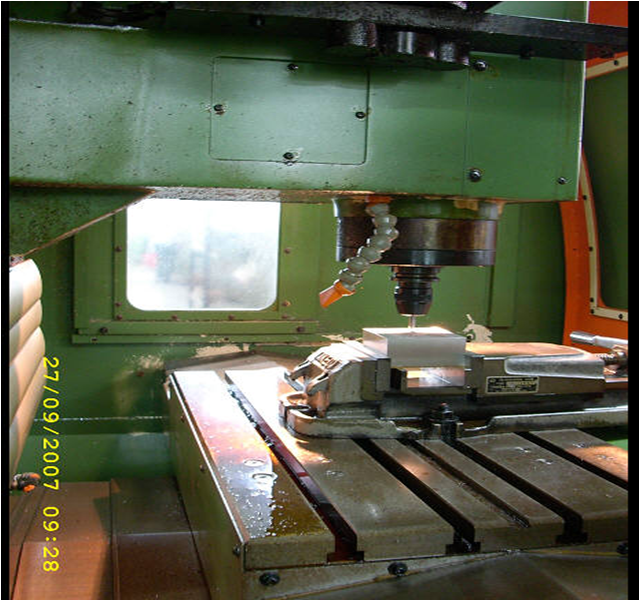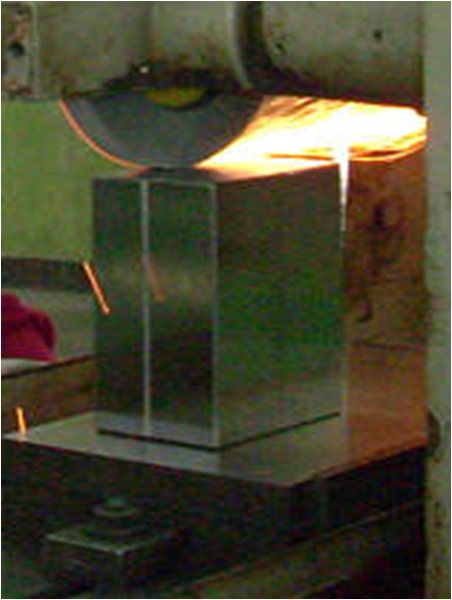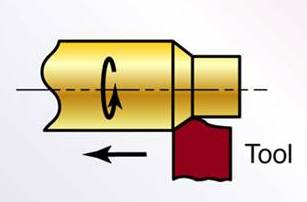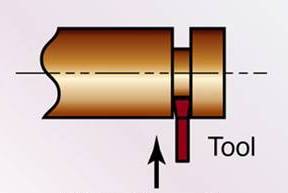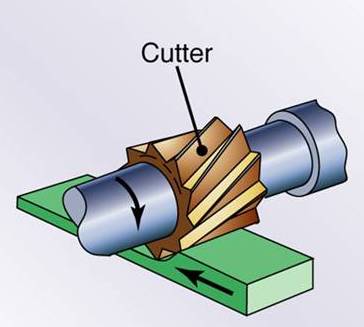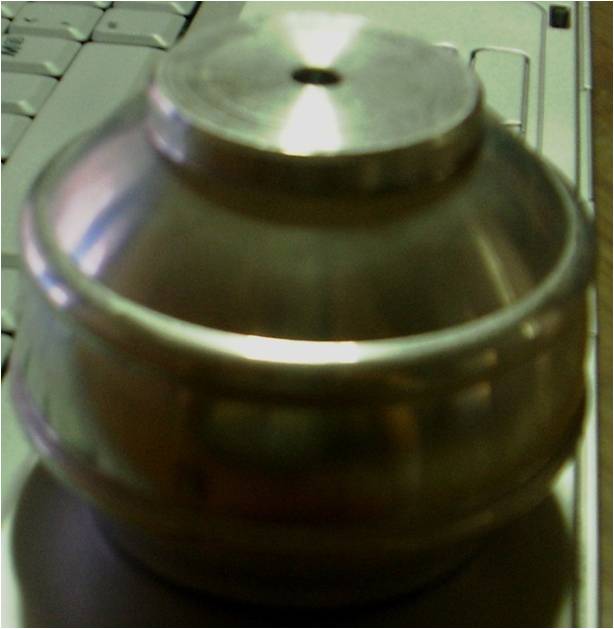Metal Cutting Process Quiz Questions

- 1.
What process is illustrated in the picture below?
- A.
Milling Machining
- B.
Lathe Machining
- C.
Grinding
- D.
Wire Cutting
- E.
None of the above
Correct Answer
A. Milling MachiningExplanation
The process illustrated in the picture is milling machining. This can be inferred from the image, which shows a machine with a rotating cutter that is removing material from a workpiece. Milling machining involves the use of a cutting tool to remove material from the surface of a workpiece, creating complex shapes and contours. This process is commonly used in manufacturing and metalworking industries.Rate this question:
-
- 2.
What is the process illustrated in the figure below?
- A.
Milling Machining
- B.
Lathe Machining
- C.
Grinding
- D.
Wire Cutting
- E.
None of the Above
Correct Answer
C. GrindingExplanation
The process illustrated in the figure is grinding. Grinding is a machining process that uses an abrasive wheel or belt to remove material from a workpiece. It is commonly used for finishing operations, such as achieving a smooth surface finish or precise dimensions. In grinding, the workpiece is held in place while the grinding wheel rotates and removes material by abrasion. This process is often used for shaping hard materials or for sharpening tools.Rate this question:
-
- 3.
What process is illustrated in the figure below?
- A.
Slab Milling
- B.
Straight Turning
- C.
Cutting Off
- D.
End Milling
- E.
None of the Above
Correct Answer
B. Straight TurningExplanation
The figure in the question likely shows a lathe machine, which is used for turning operations. Straight turning is a common process performed on a lathe, where the workpiece is rotated and a cutting tool is used to remove material and create a cylindrical shape. Slab milling involves milling a flat surface, cutting off is the process of separating a workpiece from the main stock, and end milling is used to create slots or profiles on the end of a workpiece. None of these processes are depicted in the figure, making straight turning the correct answer.Rate this question:
-
- 4.
What is the operation illustrated in the figure below?
- A.
Slab Milling
- B.
Straight Turning
- C.
Cutting Off
- D.
End Milling
- E.
None of the Above
Correct Answer
C. Cutting OffExplanation
The operation illustrated in the figure is cutting off. This is evident from the shape of the tool and the position of the workpiece. Cutting off is a machining operation used to separate a part from the rest of the workpiece by making a straight cut across it. This operation is commonly used in metalworking to create individual parts or to remove excess material.Rate this question:
-
- 5.
What is the process illustrated in the figure below?
- A.
Slab Milling
- B.
Straight Turning
- C.
Cutting Off
- D.
End Milling
- E.
None of the Above
Correct Answer
A. Slab MillingExplanation
The process illustrated in the figure is Slab Milling. Slab milling is a type of milling operation where a milling cutter is used to remove material from the surface of a workpiece in a perpendicular direction to the axis of rotation of the cutter. This process is commonly used to create flat surfaces or slots on a workpiece.Rate this question:
-
- 6.
What is the process illustrated in the figure below?
- A.
Slab Milling
- B.
Straight Turning
- C.
Cutting Off
- D.
End Milling
- E.
None of the Above
Correct Answer
D. End MillingExplanation
The process illustrated in the figure is end milling. End milling is a machining operation where a milling cutter is used to remove material from the surface of a workpiece. The milling cutter has teeth on the periphery and on the face, allowing it to cut in both axial and radial directions. This process is commonly used to create slots, pockets, and contours on a workpiece.Rate this question:
-
- 7.
Which of the following is NOT considered a major independent variable in a cutting process?
- A.
Chip Type
- B.
Cutting Speed
- C.
Workpiece Material
- D.
Tool Material
- E.
None of the Above
Correct Answer
A. Chip TypeExplanation
Chip Type is not considered a major independent variable in a cutting process. The major independent variables in a cutting process include cutting speed, workpiece material, and tool material. Chip type refers to the shape and size of the chips produced during the cutting process, which is influenced by the other independent variables rather than being an independent variable itself.Rate this question:
-
- 8.
Which of the following is NOT a major dependent variable in a cutting process?
- A.
Force and energy dissipated
- B.
Tool wear and failure
- C.
Surface finish of workpiece
- D.
Cutting Speed
- E.
None of the Above
Correct Answer
D. Cutting SpeedExplanation
Cutting speed is not a major dependent variable in a cutting process. The cutting speed refers to the speed at which the cutting tool moves across the workpiece. While it does affect the cutting process, it is not considered a major dependent variable like force and energy dissipated, tool wear and failure, and surface finish of the workpiece. These variables are directly influenced by the cutting process and have a significant impact on the outcome.Rate this question:
-
- 9.
As shear angle of a tool is decreased, which of the following would result?
- A.
Chip becomes thinner
- B.
Chip becomes thicker
- C.
Chip becomes continuous
- D.
No chip is produced
- E.
None of the Above
Correct Answer
B. Chip becomes thickerExplanation
When the shear angle of a tool is decreased, it means that the tool is cutting at a smaller angle with respect to the workpiece. This results in a higher cutting force being applied to the material. As a result, the chip that is produced will be thicker because more material is being removed during the cutting process. Therefore, the correct answer is that the chip becomes thicker.Rate this question:
-
- 10.
In which of the following conditions would a continuous chip most probably develop?
- A.
Ductile materials at high cutting speeds
- B.
Brittle materials at high cutting speeds
- C.
Ductile materials at low cutting speeds
- D.
Brittle materials at low cutting speeds
- E.
None of the above
Correct Answer
A. Ductile materials at high cutting speedsExplanation
A continuous chip is most likely to develop in ductile materials at high cutting speeds. This is because ductile materials have the ability to deform plastically under stress, allowing the chip to form continuously. At high cutting speeds, there is more energy and force applied to the material, causing it to deform and form a continuous chip. In contrast, brittle materials are more prone to fracturing and forming discontinuous chips, regardless of the cutting speed.Rate this question:
-
- 11.
Which of the following can most adversely affect the surface finish of the workpiece in a cutting process?
- A.
Continuous Chip
- B.
Built-up Edge
- C.
Serrated Chip
- D.
Discontinuous chip
- E.
None of the Above
Correct Answer
B. Built-up EdgeExplanation
Built-up Edge can most adversely affect the surface finish of the workpiece in a cutting process. Built-up Edge refers to the accumulation of material on the cutting tool during the machining process. This accumulation can cause the tool to rub against the workpiece instead of cutting cleanly, leading to poor surface finish. The built-up edge can also cause chipping or tearing of the workpiece material, further degrading the surface finish.Rate this question:
-
- 12.
Which of the following is NOT a major category of rapid prototyping?
- A.
Powder-Based
- B.
Liquid-Based
- C.
Laser-Based
- D.
Solid-Based
- E.
None of the Above
Correct Answer
C. Laser-BasedExplanation
Laser-Based is not a major category of rapid prototyping. Rapid prototyping typically involves techniques such as powder-based, liquid-based, and solid-based methods. Laser-based methods, on the other hand, are commonly used in additive manufacturing processes like selective laser sintering (SLS) or direct metal laser sintering (DMLS), which are not considered as major categories of rapid prototyping.Rate this question:
-
- 13.
Tick on the boxes that are true.
- A.
Excessive temperature adversely affects the strength, hardness, and wear resistance of the cutting tool
- B.
Increased heat causes the part being machined to be dimensionally stable
- C.
Heat can induce thermal damage to the machined surface, adversely affecting its properties
- D.
Excessive temperature may result in machine stabilization
- E.
None of the above
Correct Answer(s)
A. Excessive temperature adversely affects the strength, hardness, and wear resistance of the cutting tool
C. Heat can induce thermal damage to the machined surface, adversely affecting its properties -
- 14.
Rate of tool wear depends on the following EXCEPT:
- A.
Tool and Workpiece Materials
- B.
Tool Weight
- C.
Cutting Fluids
- D.
Cutting Speed
- E.
None of the Above
Correct Answer
B. Tool WeightExplanation
The rate of tool wear depends on various factors such as tool and workpiece materials, cutting fluids, and cutting speed. However, tool weight does not have a direct impact on the rate of tool wear. The weight of the tool may affect other aspects of the machining process, such as the stability of the tool and the machine, but it does not directly influence the rate at which the tool wears down.Rate this question:
-
- 15.
Which of the following cause(s) flank wear?
- A.
Rubbing of the tool along the machined surface, causing adhesive and/or abrasive wear
- B.
Temperature of the tool-chip interface
- C.
High cutting temperatures
- D.
Chemical affinity between the tool and the workpiece material
- E.
None of the above
Correct Answer(s)
A. Rubbing of the tool along the machined surface, causing adhesive and/or abrasive wear
C. High cutting temperaturesExplanation
Flank wear refers to the wear that occurs on the flank surface of a cutting tool during machining. This wear is caused by various factors, including rubbing of the tool along the machined surface, which leads to adhesive and/or abrasive wear. Additionally, high cutting temperatures can also contribute to flank wear. These elevated temperatures can cause the tool material to soften or even melt, leading to accelerated wear. Therefore, the correct answer includes both the rubbing of the tool along the machined surface and high cutting temperatures as causes of flank wear.Rate this question:
-
- 16.
Which of the following cause(s) crater wear?
- A.
Rubbing of the tool along the machined surface, causing adhesive and/or abrasive wear
- B.
Temperature of the tool-chip interface
- C.
High cutting temperatures
- D.
Chemical affinity between the tool and the workpiece material
- E.
None of the above
Correct Answer(s)
B. Temperature of the tool-chip interface
D. Chemical affinity between the tool and the workpiece materialExplanation
Crater wear is caused by two factors: the temperature of the tool-chip interface and the chemical affinity between the tool and the workpiece material. When the temperature at the interface becomes too high, it can lead to thermal softening and deformation of the tool material, causing wear. Additionally, if there is a chemical affinity between the tool and the workpiece material, it can result in material transfer and build-up on the tool surface, leading to wear. The other options mentioned, such as rubbing of the tool along the machined surface and high cutting temperatures, can cause other types of wear but not specifically crater wear.Rate this question:
-
- 17.
Which of the following is NOT an indicator of machinability?
- A.
Good surface finish and integrity of the machined part
- B.
Long tool life obtained
- C.
Low force and power requirements
- D.
Long and thin (stringy) curled chips
- E.
None of the above
Correct Answer
E. None of the aboveExplanation
The given options all describe indicators of machinability, except for "Long and thin (stringy) curled chips." This is not an indicator of machinability because it suggests that the chips produced during machining are long and thin, which can indicate poor chip formation and potentially lead to issues such as chip clogging or tool wear. Machinability is generally characterized by the ease and efficiency with which a material can be machined, and the other options in the question all align with this concept.Rate this question:
-
- 18.
Which of the following is/are NOT a rapid prototyping process?
- A.
3-D printing
- B.
Fused Deposition Modelling
- C.
Selective Layer Sintering
- D.
Paper Lamination Modelling
- E.
None of the Above
Correct Answer(s)
C. Selective Layer Sintering
D. Paper Lamination ModellingExplanation
Selective Layer Sintering and Paper Lamination Modelling are not rapid prototyping processes. Rapid prototyping processes involve quickly creating physical prototypes of a design, typically using computer-aided design (CAD) data. 3-D printing and Fused Deposition Modelling are examples of rapid prototyping processes as they use additive manufacturing techniques to build prototypes layer by layer. Selective Layer Sintering and Paper Lamination Modelling, on the other hand, are not commonly used rapid prototyping methods and may have longer production times or different processes involved.Rate this question:
-
- 19.
Which of the figure(s) below CANNOT be produced using only a lathe machine, if any?Figure AFigure B
- A.
Figure A
- B.
Figure B
- C.
Figures A and B
- D.
None
Correct Answer
B. Figure B -
- 20.
What is the process of melting together and coalescing of materials by means of heat called?
- A.
Cold Welding
- B.
Solid State Welding
- C.
Fusion Welding
- D.
Fission Welding
- E.
None of the above
Correct Answer
C. Fusion WeldingExplanation
Fusion welding is the process of melting together and coalescing materials by applying heat. It involves heating the materials to their melting point and then allowing them to cool and solidify, creating a strong bond between the materials. This process is commonly used in industries such as construction, automotive, and manufacturing to join metals and other materials together. Cold welding, solid state welding, and fission welding are not the correct terms for this process.Rate this question:
-
- 21.
In straight polarity, the DC current polarity of the workpiece is ______ and while the electrode is ______.
- A.
Positive, negative
- B.
Positive, positive
- C.
Negative, positive
- D.
Negative, negative
- E.
None of the above
Correct Answer
A. Positive, negativeExplanation
In straight polarity, the DC current flows from the electrode to the workpiece. This means that the workpiece is connected to the positive terminal of the power source, while the electrode is connected to the negative terminal.Rate this question:
-
Quiz Review Timeline +
Our quizzes are rigorously reviewed, monitored and continuously updated by our expert board to maintain accuracy, relevance, and timeliness.
-
Current Version
-
Mar 21, 2023Quiz Edited by
ProProfs Editorial Team -
Oct 21, 2009Quiz Created by
Mamtamayao
- Aeronautics Quizzes
- Aerospace Quizzes
- Agricultural Science Quizzes
- Astrology Quizzes
- Astronomy Quizzes
- Atom Quizzes
- Biochemistry Quizzes
- Biology Quizzes
- Biomechanics Quizzes
- Biostatistics Quizzes
- Biotechnology Quizzes
- Botany Quizzes
- Branches Of Science Quizzes
- Cytology Quizzes
- Easy Science Quizzes
- Ecology Quizzes
- Electrical Quizzes
- Embryology Quizzes
- Endocrinology Quizzes
- Engineering Quizzes
- Environmental Science Quizzes
- Epidemiology Quizzes
- Experiment Quizzes
- Forestry Quizzes
- Fossil Quizzes
- Gas Quizzes
- General Science Quizzes
- Genetics Quizzes
- Histology Quizzes
- Human Biology Quizzes
- Integrated Science Quizzes
- Invention Quizzes
- Library Science Quizzes
- Lighting Quizzes
- Liquid Quizzes
- Marine Biology Quizzes
- Microbiology Quizzes
- Molecular Biology Quizzes
- Nature Quizzes
- Neuroscience Quizzes
- Nuclear Science Quizzes
- Oceanography Quizzes
- Physics Quizzes
- Psychology Quizzes
- Science And Technology Quizzes
- Science Glossary Quizzes
- Science Knowledge Quizzes
- Science Practice Quizzes
- Scientific Method Quizzes
- Scientific Notation Quizzes
- Soil Science Quizzes
- Solar System Quizzes
- Solid Quizzes
- Zoology Quizzes
 Back to top
Back to top



